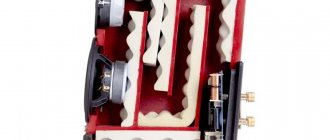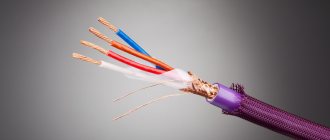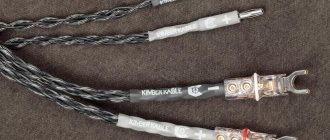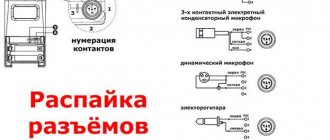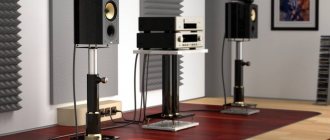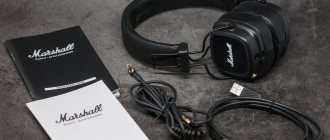Any audio component or accessory that combines an affordable price with high-tech technology from expensive high-end models always attracts increased attention. That is why we could not ignore the new generation of cables produced by the Russian company, whose name has long been heard by music lovers and audiophiles.
This year, the Russian manufacturer of cables for audio equipment Tchernov Cable has released several new products in the Special line, which represents the middle price category in the model range: power cables for installations and ready-made kits made on their basis with high-quality connectors, as well as two coaxial connectors with 75-ohm wavelength resistance, with RCA and BNC connectors. The company has updated the intercomponent cables of the Special line, fundamentally changing them. This was reflected in the name by adding the word Coaxial, indicating the specifics of the design. In fact, this is already the third generation of popular cables.
Today we have the opportunity to assemble a system that will simultaneously use all the listed new products from the Special series.
And we already had to deal with previous options. The second generation models, which came out five or six years ago, managed to make perhaps the greatest impression on our experts. In the Tchernov Cable model range there were also much more expensive audiophile products, but the Special cables won over with their price/quality ratio - they fit absolutely seamlessly into even the most capricious audio systems, and were relatively inexpensive!
Today we have the opportunity to assemble a system in which all of the listed new products from the Special series will be used simultaneously, and such a “general” approach will help to better evaluate the features of these products. Here, of course, it would be logical to start from predecessor cables, but such a comparison is impossible - the series has never had such an assortment before. So let's go sequentially. Our test system will initially be connected with standard or inexpensive proven cables, but step by step we will make replacements with Tchernov Cable and note the changes. The only line that will remain untouched is the acoustic one. The Special SC speaker system being released today is not a new product, so we decided not to touch it, and to connect the amplifier to the acoustics we simply took a high-quality cable from a third-party manufacturer that was well suited to the components of the test system.
However, before listening, a few words about how Special differs from other Tchernov Cable series.
However, before listening, a few words about how Special differs from other Tchernov Cable series. The manufacturer's budget and entry-level cables are represented by cables from the Standard and Original lines - they are mass-produced and have a fairly simple design by Hi-End standards, but are combined with the highest quality materials. Above Special are the Classic, Reference lines and, apart from that, Ultimate. All brand cables, as you know, are manufactured in Russia with conductors made of copper of Russian origin, called BRC (a proprietary abbreviation for “balanced purity copper”, that is, high purity copper in which beneficial impurities are in a certain ratio to each other, which best affects the transmission of the audio signal). The significant difference in price here is determined by design complexity, which implies the use of special equipment, patented technological solutions, a significantly larger cross-section of conductors, different combinations of insulating materials, etc. The new cables of the “Special” line incorporated both new solutions and elements used in older models, which could be transferred to a mass product without significantly increasing its cost.
Tchernov Cable Special 2.5 AC Power
1.65 meters, Euro forks, RUB 20,000.
The basis of the innovative design of the new powerhouse is the CIDAS (Cord Insulating & Damping System) system. This means that the insulated conductors for “phase”, “neutral” and “ground” are not twisted, as usual, with each other, but are interspersed with soft PVC cords - one runs along the axis, and the other three define a three-dimensional structure that the common one covers belt insulation SDB and outer shell made of thermoplastic polyurethane elastomer “Elastollan” (BASF, Germany). This design is better protected from acoustic noise and mechanical vibrations, and the symmetrical spacing of conductors reduces distributed capacitance, reduces energy losses and weakens the cable's own radio emissions. There is no screen, the conductor has a cross-section of 3 x 2.5 mm² (56 conductors with a diameter of 0.26 mm each). The cable looks much more impressive than its analogues (assembled diameter is 16.7 mm).
This design is better protected from acoustic noise and mechanical vibrations, and symmetrical conductor spacing reduces distributed capacitance.
It can be purchased in the form of ready-made kits equipped with high-quality network connectors standard IEC 60320 (C13) / CEE 7/7 with gold-plated contact group and a durable polycarbonate housing with improved vibration-damping properties, in an external protective nylon sleeve, or in measured lengths (in a coil ) for various installation projects.
What changed in the sound of the system when, observing the phasing, we replaced the standard power cables with Special AC Power cables? The most noticeable thing is a clearer beat, a more natural click of the sticks, a more meaningful sound of the drums. The main and sharpest bass components stood out more strongly - they were less “confused” with derivative harmonics and overtones, which made the transmission of the low register more intelligible. After the change, the upper range at first seemed more caustic and less comfortable (in fact, with conventional cables it was simply always washed out), but the transmission of sonorous metal instruments became more natural, and soft noise components, on the contrary, lost their acrid “taste” - namely This interpretation sounded more plausible. Everything in the scene remained almost unchanged, but some images gained a little more substance.
The main and sharpest bass components stood out more strongly - they were less “confused” with derivative harmonics and overtones.
And one more observation. One of the tested Tchernov Cable security devices was “cold”, and we thoroughly drove the second one for three days before the test. So, when the “warmed” cable supplied power to the DAC, and the one just taken out of the box was connected to the amplifier, then all the positive differences were much more obvious than when they were swapped. It is clear that the test converter is much more sensitive to the purity of the power supply than the amplifier. But the fact that the “cold” and “warm up” cables produced the same changes, setting different levels of clarity in the system, indicates that the effect of the technologies embedded in the Special 2.5 AC Power, firstly, is not immediately revealed, and secondly, then manifests itself quite strongly and, thirdly, predictably. And the last one is very important.
Tchernov Cable Special Coaxial IC
Meter pair, RCA, 10,000 rub.
This cable is marked exactly like that, with the word Coaxial, while its predecessors were produced under the names Special MkII or Special XS Mk II IC. The first one differed from the models of the junior lines in its symmetrical design and semi-air fluoroplastic waist insulation SATI. The second one also had a more complex shielding system, patented as X-Shield. The difference between the new cable model is that it is unified - it has low enough capacitance and inductance to work in analog lines, while it has a normalized characteristic impedance of 75 Ohms.
The difference between the new cable model is that it is unified - it has a fairly low capacitance and inductance.
The coaxial cable consists of: a stranded conductor with an increased cross-section (0.70 mm²), improved combined air-porous CAFPE insulation, double reinforced screen consisting of copper foil 25 microns thick and BRC braid with a density of more than 90%. The use of such a screen design makes it possible to achieve maximum suppression of electromagnetic interference over a wide band, including in the low frequency region, where the intensity of industrial interference is high. Considering the widespread proliferation of wireless systems and low-power, but “dirty” power adapters in homes, this is relevant. The outer shell of the new cable is made of the previously mentioned thermoplastic polyurethane Elastollan, which differs from similar materials in its high resistance to external influences, increased elasticity and unsurpassed damping properties. The connectors are also familiar - Special V2 with a central contact made of beryllium copper and gold plating.
Prior to the Special Coaxial IC in the system, the DAC and amplifier were connected by a reference cable, which we value for its very precise spatial focus of all virtual sources in the soundstage. It is not surprising that after the replacement it became a little different - the images retained their location, but acquired a sort of light halo around them. But how everything else has changed! The tested cable slightly smoothed out the dynamics on percussion and ringing, but at the same time seemed to expand the range - more infra-low components, which form the “foundation” of the sound of a symphony orchestra, became audible, and added atmosphere and audible reflections in the hall. The word “added” in this case is not entirely correct - the cable did not add anything to what was already recorded in the soundtrack, it simply conveyed these subtle nuances so that they became more obvious to perception.
The cable slightly smoothed out the dynamics on drums and voiced ones, but at the same time it seemed to expand the range - more infra-low components became audible.
But the Special Coaxial IC gets even more interesting when playing hard rock or live concert recordings. Drive, openness and some kind of amazing frankness appear in the music. The top is not aggressive. Vocals are presented softly and richly, with good timbral rendering, but at the same time with less clear spatial clarity, judging by the localization of the accompanying instruments. Most likely, stage accuracy will improve with further heating of the cable. The main thing is that it does not distort the space, does not move plans and does not leave any connection to the speaker systems.
Power and intercomponent cables Tchernov Cable Special line
Any audio component or accessory that combines an affordable price with high-tech technology from expensive high-end models always attracts increased attention. That is why we could not ignore the new generation of cables produced by the Russian company, whose name has long been heard by music lovers and audiophiles.
SPECIAL REALITY
This year, the Russian manufacturer of cables for audio equipment Tchernov Cable released several new products in the Special line, which represents the middle price category in the model range: power cables for installations and ready-made kits made on their basis with high-quality connectors, as well as two coaxial connectors with 75- ohm impedance, with RCA and BNC connectors. The company has updated the intercomponent cables of the Special line, fundamentally changing them. This was reflected in the name by adding the word Coaxial, indicating the specifics of the design. In fact, this is already the third generation of popular cables.
Today we have the opportunity to assemble a system that will simultaneously use all the listed new products from the Special series.
And we already had to deal with previous options. The second generation models, which came out five or six years ago, managed to make perhaps the greatest impression on our experts. In the Tchernov Cable model range there were also much more expensive audiophile products, but the Special cables won over with their price/quality ratio - they fit absolutely seamlessly into even the most capricious audio systems, and were relatively inexpensive!
Today we have the opportunity to assemble a system in which all of the listed new products from the Special series will be used simultaneously, and such a “general” approach will help to better evaluate the features of these products. Here, of course, it would be logical to start from predecessor cables, but such a comparison is impossible - the series has never had such an assortment before. So let's go sequentially. Our test system will initially be connected with standard or inexpensive proven cables, but step by step we will make replacements with Tchernov Cable and note the changes. The only line that will remain untouched is the acoustic one. The Special SC speaker system being released today is not a new product, so we decided not to touch it, and to connect the amplifier to the acoustics we simply took a high-quality cable from a third-party manufacturer that was well suited to the components of the test system.
However, before listening, a few words about how Special differs from other Tchernov Cable series.
However, before listening, a few words about how Special differs from other Tchernov Cable series.
The manufacturer's budget and entry-level cables are represented by cables from the Standard and Original lines - they are mass-produced and have a fairly simple design by Hi-End standards, but are combined with the highest quality materials. Above Special are the Classic, Reference lines and, apart from that, Ultimate. All brand cables, as you know, are manufactured in Russia with conductors made of copper of Russian origin, called BRC (a proprietary abbreviation for “balanced purity copper”, that is, high purity copper in which beneficial impurities are in a certain ratio to each other, which best affects the transmission of the audio signal). The significant difference in price here is determined by design complexity, which implies the use of special equipment, patented technological solutions, a significantly larger cross-section of conductors, different combinations of insulating materials, etc. The new cables of the “Special” line incorporated both new solutions and elements used in older models, which could be transferred to a mass product without significantly increasing its cost. Tchernov Cable Special 2.5 AC Power
1.65 meters, Euro plugs.
The basis of the innovative design of the new powerhouse is the CIDAS (Cord Insulating & Damping System) system. This means that the insulated conductors for “phase”, “neutral” and “ground” are not twisted, as usual, with each other, but are interspersed with soft PVC cords - one runs along the axis, and the other three define a three-dimensional structure that the common one covers belt insulation SDB and outer shell made of thermoplastic polyurethane elastomer “Elastollan” (BASF, Germany). This design is better protected from acoustic noise and mechanical vibrations, and the symmetrical spacing of conductors reduces distributed capacitance, reduces energy losses and weakens the cable's own radio emissions. There is no screen, the conductor has a cross-section of 3 x 2.5 mm² (56 conductors with a diameter of 0.26 mm each). The cable looks much more impressive than its analogues (assembled diameter is 16.7 mm).
This design is better protected from acoustic noise and mechanical vibrations, and symmetrical conductor spacing reduces distributed capacitance.
It can be purchased in the form of ready-made kits equipped with high-quality network connectors standard IEC 60320 (C13) / CEE 7/7 with gold-plated contact group and a durable polycarbonate housing with improved vibration-damping properties, in an external protective nylon sleeve, or in measured lengths (in a coil ) for various installation projects.
What changed in the sound of the system when, observing the phasing, we replaced the standard power cables with Special AC Power cables? The most noticeable thing is a clearer beat, a more natural click of the sticks, a more meaningful sound of the drums. The main and sharpest bass components stood out more strongly - they were less “confused” with derivative harmonics and overtones, which made the transmission of the low register more intelligible. After the change, the upper range at first seemed more caustic and less comfortable (in fact, with conventional cables it was simply always washed out), but the transmission of sonorous metal instruments became more natural, and soft noise components, on the contrary, lost their acrid “taste” - namely This interpretation sounded more plausible. Everything in the scene remained almost unchanged, but some images gained a little more substance.
The main and sharpest bass components stood out more strongly - they were less “confused” with derivative harmonics and overtones.
And one more observation.
One of the tested Tchernov Cable security devices was “cold”, and we thoroughly drove the second one for three days before the test. So, when the “warmed” cable supplied power to the DAC, and the one just taken out of the box was connected to the amplifier, then all the positive differences were much more obvious than when they were swapped. It is clear that the test converter is much more sensitive to the purity of the power supply than the amplifier. But the fact that the “cold” and “warm up” cables produced the same changes, setting different levels of clarity in the system, indicates that the effect of the technologies embedded in the Special 2.5 AC Power, firstly, is not immediately revealed, and secondly, then manifests itself quite strongly and, thirdly, predictably. And the last one is very important. Tchernov Cable Special Coaxial IC
Meter pair, RCA.
This cable is marked exactly like that, with the word Coaxial, while its predecessors were produced under the names Special MkII or Special XS Mk II IC. The first one differed from the models of the junior lines in its symmetrical design and semi-air fluoroplastic waist insulation SATI. The second one also had a more complex shielding system, patented as X-Shield. The difference between the new cable model is that it is unified - it has low enough capacitance and inductance to work in analog lines, while it has a normalized characteristic impedance of 75 Ohms.
The difference between the new cable model is that it is unified - it has a fairly low capacitance and inductance.
The coaxial cable consists of: a stranded conductor with an increased cross-section (0.70 mm²), improved combined air-porous CAFPE insulation, double reinforced screen consisting of copper foil 25 microns thick and BRC braid with a density of more than 90%. The use of such a screen design makes it possible to achieve maximum suppression of electromagnetic interference over a wide band, including in the low frequency region, where the intensity of industrial interference is high. Considering the widespread proliferation of wireless systems and low-power, but “dirty” power adapters in homes, this is relevant. The outer shell of the new cable is made of the previously mentioned thermoplastic polyurethane Elastollan, which differs from similar materials in its high resistance to external influences, increased elasticity and unsurpassed damping properties. The connectors are also familiar - Special V2 with a central contact made of beryllium copper and gold plating.
Prior to the Special Coaxial IC in the system, the DAC and amplifier were connected by a reference cable, which we value for its very precise spatial focus of all virtual sources in the soundstage. It is not surprising that after the replacement it became a little different - the images retained their location, but acquired a sort of light halo around them. But how everything else has changed! The tested cable slightly smoothed out the dynamics on percussion and ringing, but at the same time seemed to expand the range - more infra-low components, which form the “foundation” of the sound of a symphony orchestra, became audible, and added atmosphere and audible reflections in the hall. The word “added” in this case is not entirely correct - the cable did not add anything to what was already recorded in the soundtrack, it simply conveyed these subtle nuances so that they became more obvious to perception.
The cable slightly smoothed out the dynamics on drums and voiced ones, but at the same time it seemed to expand the range - more infra-low components became audible.
But the Special Coaxial IC gets even more interesting when playing hard rock or live concert recordings.
Drive, openness and some kind of amazing frankness appear in the music. The top is not aggressive. Vocals are presented softly and richly, with good timbral rendering, but at the same time with less clear spatial clarity, judging by the localization of the accompanying instruments. Most likely, stage accuracy will improve with further heating of the cable. The main thing is that it does not distort the space, does not move plans and does not leave any connection to the speaker systems. Tchernov Cable Special Coaxial IC
1 meter, Digital RCA.
1 meter, Digital BNC.
These are perhaps the most interesting specimens in our study. Based on the cables described above, the company now produces digital 75-ohm connectors. The one with RCA terminals is designed for all standard SPDIF lines and, as we further verified in the test, it easily passes streams up to 192 kHz/24 bits from the network streamer to the DAC. The second, with BNC terminals, is nominally intended for additional Master Clock synchronization if an external reference clock is used along with the DAC and transport. But nothing prevents you from installing it in the SPDIF line if the equipment (as in our case) has inputs/outputs on the corresponding sockets.
The scale of the scene enlarged and the distant shot moved slightly closer. Localization with slight “halos” intensified, the general atmosphere stood out well.
These cables differ from analog versions in that they are additionally protected by a nylon jacket. In addition, the RCA version uses other tips - larger in diameter, so that in the place where the central core and screen are soldered, a wave impedance close to 75 Ohms is also maintained. The BNC version provides this by default. In fact, this standard for coaxial connections was created so that there is no step change in parameters at the connection point, which can cause a temporary mismatch (i.e., essentially local jitter) in the digital signal transmission line.
Before the inclusion of Special Coaxial IC cables, the signal from the streamer to the DAC could be transmitted in two alternative ways - either via SPDIF with a high-quality silver-plated video cable with RCA connectors (guaranteed to provide the required 75 Ohms and has a bandwidth with a large margin for digital audio equipment), or via asynchronous USB 2.0 protocol.
Replacing the first one with Special Coaxial IC RCA gave a different interpretation at high frequencies. The reproduction turned out to be a little richer in noise or “rustling” shades - the metal was cut through less sharply, but the “brush” overtones sounded more interesting. The scale of the scene enlarged and the distant shot moved slightly closer. Localization with slight “halos” intensified, the general atmosphere stood out well, and the lower register remained in perfect order - the materiality in it did not decrease one iota. The result as a whole can be characterized as follows: the sound has become somewhat less detailed, but it turned out to be very natural and comfortable. Even in comparison with the asynchronous USB protocol, which is much preferable to SPDIF for Hi-Res Audio playback (since there is no clocking problem - possible jitter is due only to the quality of the clock in the DAC), the Special Coaxial IC RCA showed itself to be interesting - it brought the sound quite similar to live melodiousness.
The most difficult orchestral or acoustic recordings sounded flawlessly - neutral, detailed and large-scale, without distorting the stage.
But Special Coaxial IC BNC turned out to be even cooler. The background returned to its place, the metal stood out very clearly, and all the drums came out more prominently. The most difficult orchestral or acoustic recordings sounded flawlessly - neutral, detailed and large-scale, without distorting the stage. But in the “electric” genres this advantage was no longer so noticeable - there they won not so much with pedantry as with euphony. In short, the BNC version of the cable in our system “puts the rest of the digital connections to shame” by almost all technical and aesthetic criteria. And we have no doubt that its accuracy will be an additional advantage in advanced systems with Master Clock.
The final listening also revealed what the strength of the new Special cables is when they work together. Those responsible for nutrition are, as it were, responsible for the dynamics - they add drive, eliminate tonal indistinctness in complex fragments, and highlight the microdynamic pattern. Intercomponent analog adds specificity, substance and softness to this picture. Digital ones also work as a kind of “plasticizer” in the middle and upper register, and one, at the cost of easy stage transformation, gives the illusion of a more “contact” sound, and the second captivates with its spatial accuracy and timbral honesty. And all together they allow you to extract a more lively, sophisticated and comfortable sound from the system.
COMPONENTS
- Network transport Lumin U1 Mini
- Laptop Apple MacBook Air A1465
- Aqua La Scala Mk II DAC
- Naim Supernait 2 integrated amplifier
- Totem Forest Signature Speaker Systems
- Cables
- digital USB InAkustik Referenz High Speed USB 2.0
- interconnect RCA InAkustik Referenz NF-102
- acoustic TelluriumQ Blue Diamond
Source: salonav.com
Go to the manufacturer's catalog


